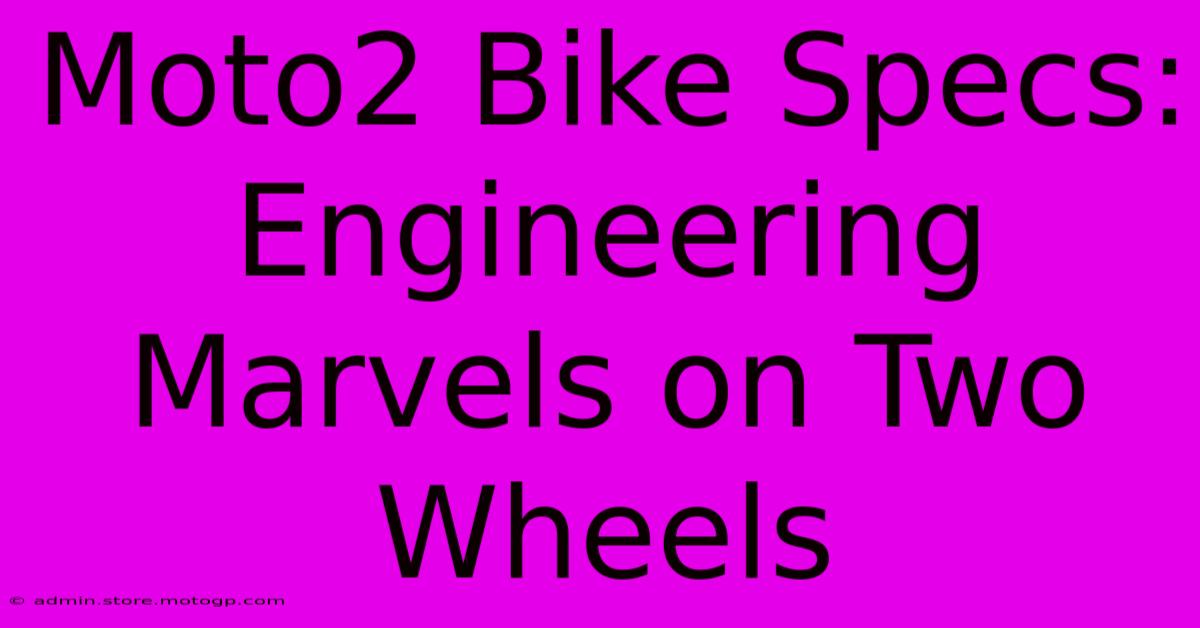Moto2 Bike Specs: Engineering Marvels On Two Wheels

Table of Contents
Moto2 Bike Specs: Engineering Marvels on Two Wheels
The Moto2 class in Grand Prix motorcycle racing represents a fascinating blend of cutting-edge technology and strictly regulated standardization. Unlike MotoGP, where manufacturers compete with vastly different engine designs, Moto2 features a single engine supplier, ensuring a level playing field focused on chassis development, rider skill, and strategic setup. This article delves into the intricate specifications of these engineering marvels, exploring the key components that contribute to their thrilling performance.
The Triumph 765cc Triple Engine: A Shared Powerhouse
At the heart of every Moto2 bike beats a Triumph 765cc inline-triple engine, a significant departure from the previous Honda-supplied engines. This engine, a derivative of the powerplant found in the Triumph Street Triple RS, has been meticulously developed for racing. While specific power figures aren't publicly released, it's known to deliver exhilarating performance, exceeding 130bhp and boasting a screaming, characteristic triple-cylinder soundtrack. The engine is sealed, meaning teams cannot modify internal components, focusing their efforts on optimizing the chassis and electronics.
Key Engine Features:
- 765cc Inline-Triple: This configuration provides a unique power delivery and a distinct engine character.
- Sealed Unit: Prevents internal modifications, emphasizing chassis setup and rider skill.
- High Revving: Designed for high RPM operation, maximizing power output throughout the rev range.
- Sophisticated Electronics: Includes advanced engine management systems for optimal performance and reliability.
Chassis Dynamics: The Art of Fine-Tuning
While the engine is standardized, the chassis is where teams truly showcase their engineering prowess. Each team develops its own unique chassis, employing varying materials, geometries, and suspension setups. This contributes to the diverse riding styles and strategies witnessed on the track.
Crucial Chassis Components:
- Frame: Typically constructed from aluminum, often using sophisticated techniques like twin-spar or trellis designs. The frame's rigidity and flex characteristics are crucial for handling and stability.
- Suspension: Teams utilize high-performance Öhlins suspension units, allowing for precise adjustments to damping and spring rates. This enables fine-tuning for specific tracks and rider preferences.
- Brakes: High-performance braking systems, often featuring Brembo calipers and discs, are essential for slowing down these powerful machines. Brake feel and control are paramount for consistent lap times.
- Wheels: Lightweight magnesium wheels reduce unsprung mass, improving handling and responsiveness. The choice of wheel design also impacts the bike's overall balance.
Electronics: A Symphony of Sensors and Algorithms
Modern Moto2 bikes are equipped with sophisticated electronics packages that play a critical role in performance and rider safety. These systems monitor various parameters, providing real-time data and enabling adjustments to enhance control and consistency.
Essential Electronic Systems:
- Traction Control: Prevents wheelspin, maximizing acceleration and maintaining stability.
- Engine Braking Control: Manages engine braking, improving rider feel and stability under braking.
- Wheelie Control: Limits front-wheel lift-off, improving acceleration and safety.
- Data Acquisition Systems (DAQ): Collect extensive data during races and testing, providing valuable insights for setup optimization.
The Future of Moto2: Continuous Evolution
Moto2 continues to evolve, pushing the boundaries of motorcycle technology within the confines of its regulations. The constant refinement of chassis designs, suspension setups, and electronic control systems ensures intense competition and thrilling racing. The class serves as a crucial breeding ground for future MotoGP stars, honing their skills and preparing them for the ultimate challenge of premier-class racing. The standardization of the engine focuses development on the crucial areas of rider skill and chassis engineering, making Moto2 a captivating spectacle of precision, power, and strategic prowess.

Thank you for visiting our website wich cover about Moto2 Bike Specs: Engineering Marvels On Two Wheels. We hope the information provided has been useful to you. Feel free to contact us if you have any questions or need further assistance. See you next time and dont miss to bookmark.
Featured Posts
-
Tnt Sports Moto Gp Where Passion Meets Performance
Feb 18, 2025
-
Tnt Moto Gp Expert Analysis Unrivaled Access
Feb 18, 2025
-
Beyond Fast Exploring The Horsepower Of Moto Gp
Feb 18, 2025
-
Moto Gp Aero And Cornering The Grip Advantage
Feb 18, 2025
-
Bike Racing On Tv Where Legends Are Made
Feb 18, 2025
